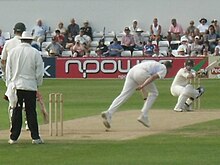Phillip Hughes
[6] On 25 November 2014, Hughes was hit in the neck by a bouncer from Sean Abbott, during a Sheffield Shield match at the Sydney Cricket Ground, causing a vertebral artery dissection that led to a subarachnoid haemorrhage.[7] Hughes was taken to St Vincent's Hospital in Sydney, where he underwent surgery, was placed into an induced coma, and was in intensive care in a critical condition.[16] In a comfortable victory for New South Wales, Hughes opened the batting and got his career off to a solid start, scoring a fluent 51 and taking 2 catches.[19] Hughes was rewarded for his achievements by winning the New South Wales Rising Star Award and earning an upgrade to a full state contract for the 2008–09 season."[27]Hughes hit consecutive hundreds at the end of the 2010/11 season to earn the praise of Australian chairman of selectors Andrew Hilditch.[30] After New South Wales' wicket-keeper Brad Haddin was struck in the head by a top edge, Hughes took on the keeping duties for nine overs.[31] After consistently making runs at domestic level, Hughes was called up to replace Matthew Hayden on Australia's tour of South Africa in February and March 2009.He was dropped from the team for the third Edgbaston Test in favour of Shane Watson, who opened the batting in his place and provided the Australians with an extra bowling option.[35][36] Upon his return from South Africa, the Phillip Hughes Award, to be given annually to a promising young cricketer from the local district, was announced in his home town of Macksville.He was a regular in the Australian team for the following year, playing in the last three Ashes tests, tours of Sri Lanka and South Africa and then a home series against New Zealand, but his spot came under pressure due to his inconsistency during that time.[41] In a stint for Worcestershire in the English County Cricket competition, Hughes made adjustments to his much maligned technique resulting in a more expansive range of strokes with more emphasis on legside play.These returns earned Hughes a recall to the Australian Test team to face Sri Lanka in Hobart following the retirement of Ricky Ponting in December 2012.Immediately he made an impact, scoring a solid 86 in the first Test match at Hobart, with a new-found confidence and tighter technique that had eluded him 12 months prior.[45] He opened the innings with Aaron Finch at Melbourne, and he added a 140-run third-wicket partnership with captain George Bailey before being dismissed by Lasith Malinga.Following his successful summer season in Australia in 2012/2013, Hughes was selected to play in the Test series in India, but he struggled, scoring 147 runs in eight innings and averaging only 18.37.He collapsed before receiving mouth-to-mouth resuscitation and was subsequently taken to St Vincent's Hospital, Sydney, where he underwent surgery and was placed into an induced coma.[69] The final result of the investigation was that the death of Hughes was a tragic accident arising from a minuscule misjudgement from the batsman and no players or umpires were at fault.Play on the second day of the third Test between Pakistan and New Zealand in the United Arab Emirates was suspended, due to its scheduled start occurring not long after Hughes's death.[77] During the first Test, David Warner and Steve Smith both raised their bats in commemoration of Phillip Hughes when they passed 63 not out, and when Australia reached 408 runs, the match temporarily stopped as the crowd recognised the occasion.


Philip Hughes (disambiguation)Macksville, New South WalesSydneyRight-armoff breakAustraliaSouth AfricaEnglandSri LankaPakistanNew South WalesMiddlesexHampshireWorcestershireSouth AustraliaAdelaide StrikersMumbai IndiansSydney ThunderBatting averageWicketsBowling average5 wickets in inningsstumpingsOne Day InternationalDurbanDoug WaltersMelbournebouncerSean AbbottSheffield ShieldSydney Cricket Groundvertebral artery dissectionsubarachnoid haemorrhageSt Vincent's Hospitalinduced comaItalianrugby leagueAustralia internationalGreg InglisWestern Suburbs District Cricket ClubSydney Grade CricketHomebush Boys High2008 ICC Under-19 Cricket World CupMortlakeGrade Cricket2007–08 seasonfirst-classTasmaniaMichael ClarkePura CupVictoria2008–09 seasonMurali Kartik2009 English cricket seasonCounty ChampionshipFriends Provident TrophyTwenty20 CupICC World Twenty20Stanford Super SeriesAndrew HilditchList AMelbourne Cricket GroundPhil JaquesBrad HaddinMatthew HaydenAustralia's tour of South AfricaNew Wanderers StadiumDale SteynKingsmead, Durban2009 AshesEdgbastonShane WatsonAllan Border Medalagainst Pakistantour of New Zealand2010–11 AshesColomboJohannesburgMartin GuptillChris MartinRyobi CupRicky PontingJohn InverarityAaron FinchcaptainGeorge BaileyLasith MalingaTest series in India2013 AshesAshton AgarTrent BridgeUnited Arab EmiratesTwenty20 InternationalBradman Young Cricketer of the Year2008/09Angus cattleDavid WarnerAnthony Mundinehelmetmouth-to-mouth resuscitationSt Vincent's Hospital, Sydneydefibrillatorscoronial inquestPakistan and New ZealandSri Lanka and EnglandMacksville High SchoolCricket AustraliaJames SutherlandTom CooperTony AbbottIndian team2015 Cricket World Cupretirednot out2015 Boat RaceOxfordCambridgeUrthboyMatthew WadeBarmy ArmyparodyWinter WonderlandThe GabbaBrisbaneList of unusual deaths in the 21st centuryRay Chapman